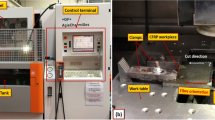Abstract
Adopting orthogonal experiments, relevant machinability in wire cut electrical discharge machining (WEDM) of 2D C/SiC composite was studied. The effects of electrical machining parameters (namely pulse width, pulse interval, and the number of tubes) on machining speed and surface roughness were analyzed. In addition, the effect of fiber orientations on the machinability was also studied. The main effect and interaction of the selected electrical machining parameters were also discussed. The key results show that the fiber orientation effect on machining speed plays a weaker role in WEDM of this composite. For machining speed, the number of tubes and the pulse interval have no interaction in both of machining directions A and B. For surface roughness, the number of tubes and the pulse interval have obvious interaction in both of machining directions A and B. The fiber orientation has a larger effect on the surface roughness than that on machining speed in WEDM of this composite. After analyzing the material removal mechanism, some new significant results show that the carbon fibers are removed in the form of transverse and longitudinal fracture. Interfacial debonding between fiber carbon and SiC matrix, pit, and recast layer form on the machined surface. Micro cracks are observed in the carbon fiber, and a part of the micro cracks are cross.
Similar content being viewed by others
References
Lu ZL, Lu F, Cao JW, Li DC, Lian YY, Miao K, **g H (2013) Fabricating hollow turbine blades using short carbon fiber-reinforced SiC composite. Int J Adv Manuf Technol 69(1–4):417–425
Zhang Y, Zhang LT, He JY, Chen C, Cheng LF, Liu YS (2018) Modelling shear behaviors of 2D C/SiC z-pinned joint prepared by chemical vapor infiltration. Ceram Int 44(6):6433–6442
Liu Q, Huang GQ, Xu XP, Fang CF, Cui CC (2017) A study on the surface grinding of 2D C/SiC composites. Int J Adv Manuf Technol 93(1):1–9
Ghafarizadeh S, Chatelain JF, Lebrun G (2016) Finite element analysis of surface milling of carbon fiber-reinforced composites. Int J Adv Manuf Technol 87(1–4):1–11
He YL, Qing HN, Zhang SG, Wang DZ, Zhu SW (2017) The cutting force and defect analysis in milling of carbon fiber-reinforced polymer (CFRP) composite. Int J Adv Manuf Technol 93(2):1–14
Shan CW, Dang J, Yan JQ, Zhang X (2017) Three-dimensional numerical simulation for drilling of 2.5D carbon/carbon composites. Int J Adv Manuf Technol 93(5–8):2985–2996
Tang WL, Chen Y, Yang HJ, Wang H, Yao Q (2018) Numerical investigation of delamination in drilling of carbon fiber reinforced polymer composites. Appl Compos Mater:1–21
Ha CS, Son EJ, Cha JH, Kang MC, Lee HJ (2017) Energy-controlled micro electrical discharge machining for an Al2O3-carbon nanotube composite. J Electr Eng Technol 12(6):1921–1718
Ninz P, Landfried R, Kern F, Gadow R (2015) Electrical discharge machining of metal doped Y-TZP/TiC nanocomposites. J Eur Ceram Soc 35(14):4031–4037
Kumar SV, Kumar MP (2015) Machining process parameter and surface integrity in conventional EDM and cryogenic EDM of Al-SiCp, MMC. J Manuf Process 20:70–78
Saxena KK, Agarwal S, Khare SK (2016) Surface characterization, material removal mechanism and material migration study of micro EDM process on conductive SiC. Procedia Cirp 42:179–184
Wang JJ, Zhang JF, Feng PF (2017) Effects of tool vibration on fiber fracture in rotary ultrasonic machining of C/SiC ceramic matrix composites. Compos Part B 129:233–242
Saxena KK, Srivastava AS, Agarwal S (2015) Experimental investigation into the micro-EDM characteristics of conductive SiC. Ceram Int 42(1):1597–1610
Wu ML, Ren CZ, Xu HZ (2016) Comparative study of micro topography on laser ablated C/SiC surfaces with typical uni-directional fibre ending orientations. Ceram Int 42(7):7929–7942
Ding K, Fu YC, Su HH, Chen Y, Yu XH, Ding GZ (2014) Experimental studies on drilling tool load and machining quality of C/SiC composites in rotary ultrasonic machining. J Mater Process Technol 214(12):2900–2907
Ji RJ, Liu YH, Zhang YZ, Cai BP, Ma JM, Li XP (2012) Influence of dielectric and machining parameters on the process performance for electric discharge milling of SiC ceramic. Int J Adv Manuf Technol 59:127–136
Liu YS, Wang CH, Li WN, Yang XJ, Zhang Q, Cheng LF, Zhang LT (2014) Effect of energy density on the machining character of C/SiC composites by picosecond laser. Appl Phys A Mater 116(3):1221–1228
Zhang LF, Ren CZ, Ji CH, Wang ZQ, Chen G (2016) Effect of fiber orientations on surface grinding process of unidirectional C/SiC composites. Appl Surf Sci 366:424–431
Diaz OG, Axinte DA (2017) Towards understanding the cutting and fracture mechanism in ceramic matrix composites. Int J Mach Tools Manuf 118–119:12–25
Wang Y, Sarin VK, Lin B, Li H, Gillard S (2016) Feasibility study of the ultrasonic vibration filing of carbon fiber reinforced silicon carbide composites. Int J Mach Tools Manuf 101:10–17
Liao ZR, Axinte DA (2016) On chip formation mechanism in orthogonal cutting of bone. Int J Mach Tools Manuf 102:41–55
Du JG, Ming WY, Ma J, He WB, Cao Y, Li XK, Liu K (2018) New observations of the fiber orientations effect on machinability in grinding of C/SiC ceramic matrix composite. Ceram Int 44(12):13916–13928
Funding
This study was funded by the Natural Science Foundation of China (grant number 51505434); the Natural Science Foundation of Henan Province (grant numbers 182300410215 and 182300410170); the Henan Province’s Scientific and Technological Project (grant number 172102210547); and Henan Province’s University Education Department Program for Innovative Research Team (in Science and Technology) (18IRTSTHN015).
Author information
Authors and Affiliations
Corresponding author
Ethics declarations
Conflict of interest
The authors declare that they have no conflict of interest.
Rights and permissions
About this article
Cite this article
He, W., He, S., Du, J. et al. Fiber orientations effect on process performance for wire cut electrical discharge machining (WEDM) of 2D C/SiC composite. Int J Adv Manuf Technol 102, 507–518 (2019). https://doi.org/10.1007/s00170-018-03210-y
Received:
Accepted:
Published:
Issue Date:
DOI: https://doi.org/10.1007/s00170-018-03210-y




